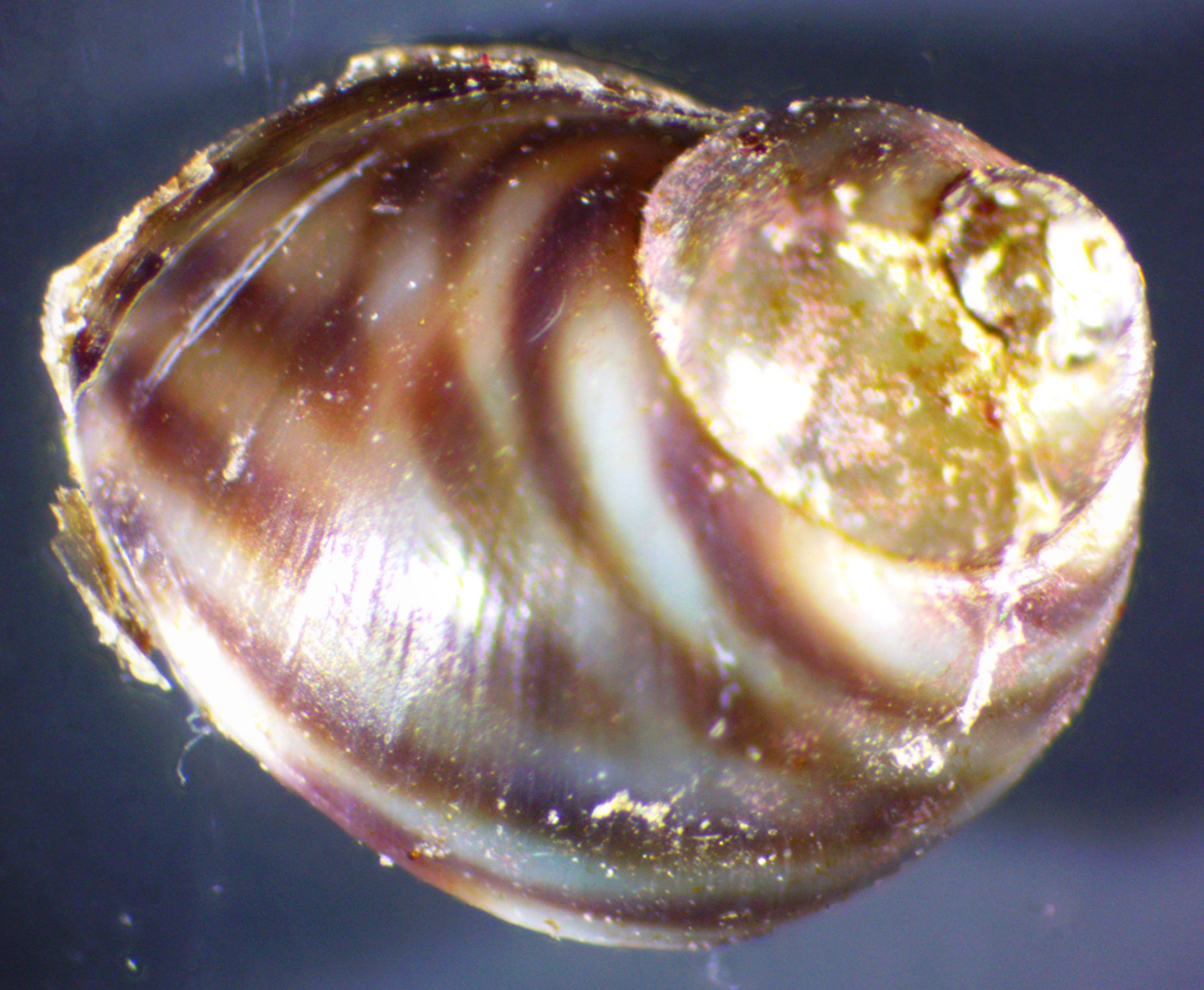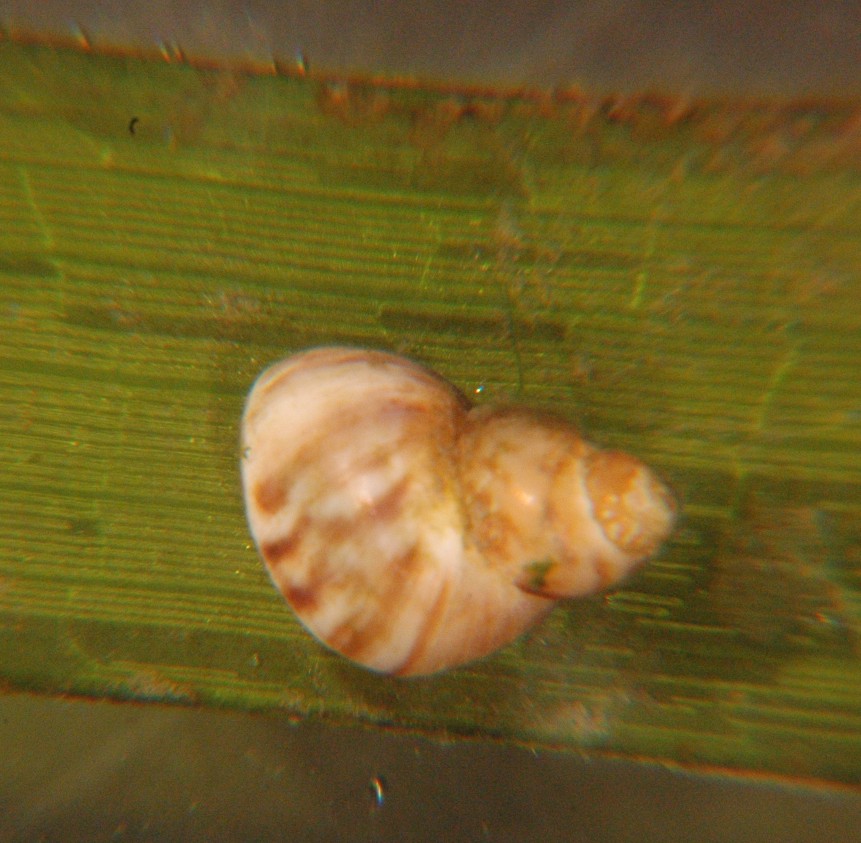How to Distinguish from Similar Species: The species may look much like Littorina scutulata, but L. scutulata has no open umbilicus and is found in the high intertidal on rocks while this species is usually in the very low intertidal or subtidal on eelgrass or algae. Several other local Lacuna have apertures 2/3 the height of the shell. L. vincta has a spiral white band and is found on rocky shores.
Geographical Range: Prince William Sound, Alaska to southern California. Unlikely to be found south of Washington State.
Depth Range: Mid to low intertidal and subtidal
Habitat: Mainly on eelgrass.
Biology/Natural History: Lives and feeds on macroalgae, or lives on surfgrass or eelgrass and feeds on diatoms on the eelgrass surface. They are much more likely to be found on this vegetation than on rocks. They graze using the front few rows of teeth on their radula. The radula has about 53-99 rows of teeth (mean 77.8) (Grunbaum and Padilla, 2014). About 3 rows of teeth are formed new each day (Padilla et al., 1996), at the back of the radula, and move forward, so the animal feeds with the oldest teeth it has. Each row of teeth is of one of two forms: sharp-pointed teeth, found on animals grazing on macroalgae. These teeth are used to rip deeply into the macroalgae. The second form of teeth is more blunt, and is found on animals grazing on eelgrass or surfgrass. These teeth are used to scrape diatoms off the eelgrass surface. The teeth are of these two forms, without intermediates. The animals can move back and forth between eelgrass and macroalgae, and the form of new teeth they produce changes when they make the move. However, since they feed with their oldest teeth, there is a lag time between when they make a move and when their feeding teeth are optimal for the substrate they are on. (Grunbaum and Padilla, 2014)
Adults can disperse by producing a 'parachute' composed of a string of mucus. This allows the animal to drift with the current to a new location. Triggers for this behavior include lack of food, presence of predators, or physical disturbance.
Lacuna
species hybridize readily
and can be hard to distinguish. This species usually lives
for 6-12
months and has separate sexes. Fertilization is
internal. The
female lays a small ring of eggs on eelgrass or kelp. They
may lay
eggs year-round, but most commonly in late spring/early summer around
Rosario.
The ring is greenish as first but becomes yellow as the eggs
mature.
After about 5 days the eggs hatch as planktonic veliger
larvae. The
larvae swim for 8-24 weeks before settling at a shell length of about 1
mm.
| Return to: | |||
| Main Page | Alphabetic Index | Systematic Index | Glossary |
References:
Dichotomous Keys:Kozloff 1987, 1996
General References:
Kozloff,
1993
Lamb
and Hanby, 2005
O'Clair
and O'Clair, 1998
Scientific Articles:
Grunbaum,
Daniel, and Dianna K. Padilla, 2014. An integrated
modeling approach
to assessing linkages between environment, organism, and phenotypic
plasticity.
Integrative and Comparative Biology 54:2 pp 323-335
Martel, A. and F.S. Chia, 1991. Foot-raising behaviour and active participation during the initial phase of post-metamorphic drifting in the gastropod Lacuna spp. Marine Ecology Progress Series 72: pp247-254
Martel, A. and F.S. Chia, 1991. Drifting and dispersal of small bivalves and gastropods with direct development. Journal of Experimental Marine Biology and Ecology 150: pp 131-147
Martel, A., and T. Diefenbach, 1993. Effects of body size, water current and microhabitat on mucous-thread drifting in post-metamorphic gastropods Lacuna spp. Marine Ecology Progress Series 99: pp215-220
Padilla, D.K., D.E. Dittman, J. Franz, and R. Sladek, 1996. Radular production rates in two species of Lacuna Turton (Gastropoda:Littorinidae). Journal of Molluscan Studies 62: pp275-280
Yee, A.K., K.L. VanAlstyne,
and D.K. Padilla,
2014. Chemical signaling in an inducible offence.
Integrative
and Comparative Biology 54(supplement 1): pp e252-275
Web sites:
General Notes and
Observations: Locations,
abundances, unusual behaviors:
These snails and their eggs are common on the eelgrass
of Padilla
Bay.

This view shows both the operculum
and the open umbilicus.
Note that the aperture
is very close to or just over half the height of the shell.

Stacked photo of an individual collected in 2018 from Padilla Bay eelgrass.
Authors and Editors of Page:
Dave Cowles (2008): Created original page
CSS coding for page developed by Jonathan Cowles (2007)
